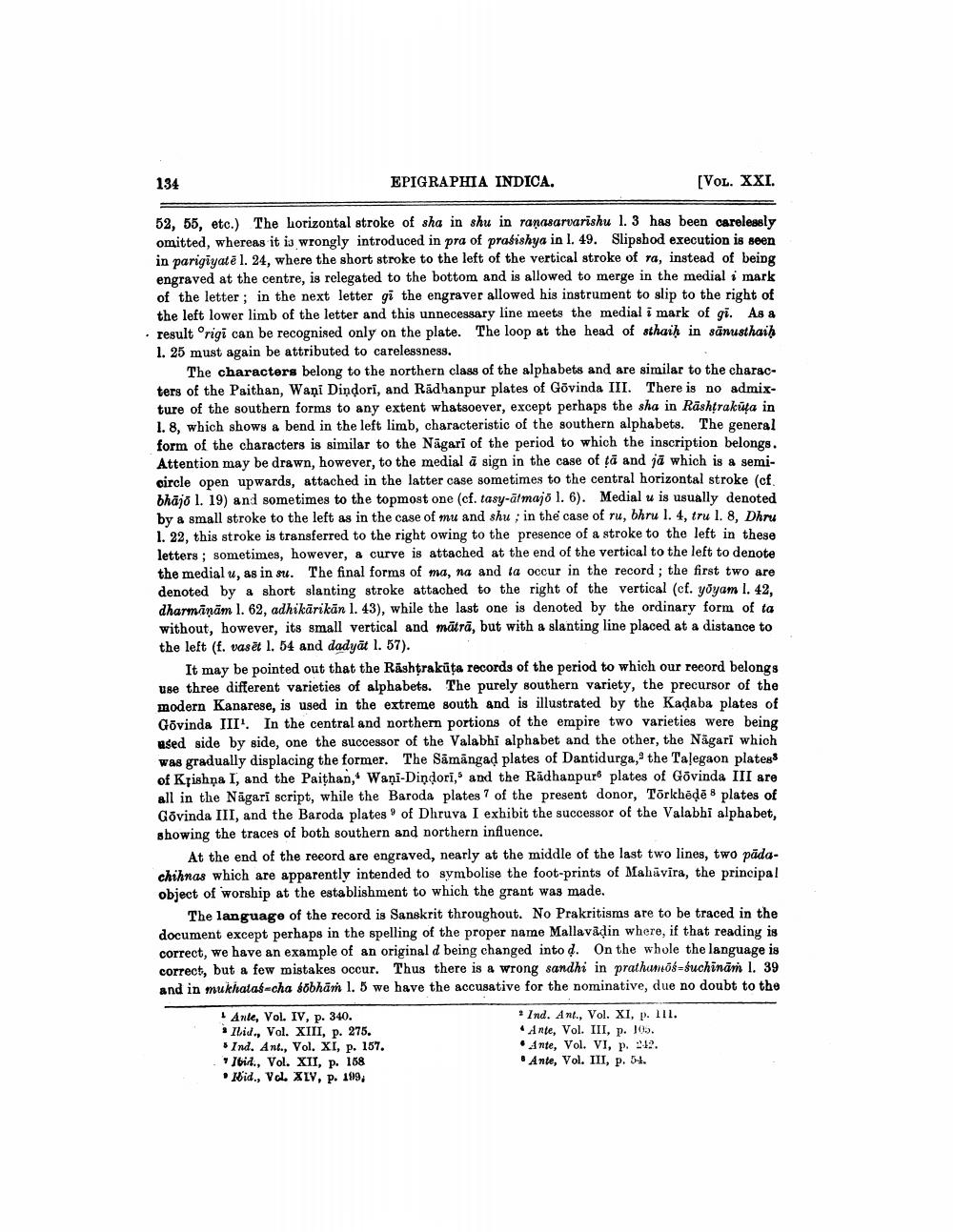________________
134
EPIGRAPHIA INDICA.
[VOL. XXI.
52, 55, etc.) The horizontal stroke of sha in shu in ranasarvarishu 1. 3 has been carelessly omitted, whereas it is wrongly introduced in pra of prasishya in l. 49. Slipshod execution is seen in parigiyatē l. 24, where the short stroke to the left of the vertical stroke of ra, instead of being engraved at the centre, is relegated to the bottom and is allowed to merge in the medial i mark of the letter; in the next letter gi the engraver allowed his instrument to slip to the right of
the left lower limb of the letter and this unnecessary line meets the medial i mark of gi. As a • result origi can be recognised only on the plate. The loop at the head of sthaih in sämusthaih 1. 25 must again be attributed to carelessness.
The characters belong to the northern class of the alphabets and are similar to the characters of the Paithan, Wani Dindori, and Rādhanpur plates of Govinda III. There is no admixture of the southern forms to any extent whatsoever, except perhaps the sha in Rashtrakūta in 1.8, which shows a bend in the left limb, characteristic of the southern alphabets. The general form of the characters is similar to the Nagari of the period to which the inscription belongs. Attention may be drawn, however, to the medial à sign in the case of tā and ja which is a semicircle open upwards, attached in the latter case sometimes to the central horizontal stroke (cf. bhājo 1. 19) and sometimes to the topmost one (cf. tasy-ālmajo 1. 6). Medial u is usually denoted by a small stroke to the left as in the case of mu and shu ; in the case of ru, bhru 1. 4, tru l. 8, Dhru 1. 22, this stroke is transferred to the right owing to the presence of a stroke to the left in these letters; sometimes, however, a curve is attached at the end of the vertical to the left to denote the medial u, as in su. The final forms of ma, na and ta occur in the record; the first two are denoted by a short slanting stroke attached to the right of the vertical (cf. yoyam 1. 42, dharmanām I. 62, adhikärikän 1. 43), while the last one is denoted by the ordinary form of ta without, however, its small vertical and mātrā, but with a slanting line placed at a distance to the left (f. vasēt 1. 54 and dadyāt l. 57).
It may be pointed out that the Rashtrakūta records of the period to which our record belongs use three different varieties of alphabets. The purely southern variety, the precursor of the modern Kanarese, is used in the extreme south and is illustrated by the Kadaba plates of Govinda III'. In the central and northern portions of the empire two varieties were being used side by side, one the successor of the Valabhi alphabet and the other, the Nägari which was gradually displacing the former. The Sämängad plates of Dantidurga,' the Talegaon plates of Krishna I, and the Paithan,* Wani-Dindori,and the Rādhanpur plates of Govinda III are all in the Nägari script, while the Baroda plates 7 of the present donor, Törkhēdē8 plates of Govinda III, and the Baroda plates of Dhruva I exhibit the successor of the Valabhi alphabet, showing the traces of both southern and northern influence.
At the end of the record are engraved, nearly at the middle of the last two lines, two pädachihnas which are apparently intended to symbolise the foot-prints of Mahavira, the principal object of worship at the establishment to which the grant was made.
The language of the record is Sanskrit throughout. No Prakritisms are to be traced in the document except perhaps in the spelling of the proper name Mallavādin where, if that reading is correct, we have an example of an original d being changed intod. On the whole the language is correct, but a few mistakes occur. Thus there is a wrong sandhi in prathumöf=suchinän I. 39 and in mukhalas-cha sobhāṁ 1. 5 we have the accusative for the nominative, due no doubt to the
Anke, Vol. IV, p. 340. Ibid., Vol. XIII, p. 275. Ind. Ant., Vol. XI, p. 157. Ibid., Vol. XII, p. 158 Nid., Vol. XIV, p. 199
* Ind. Ant., Vol. XI, p. 111. . Ante, Vol. III, p. 105. . Ante, Vol. VI, p. 249. Ante, Vol. III, p. 54.




